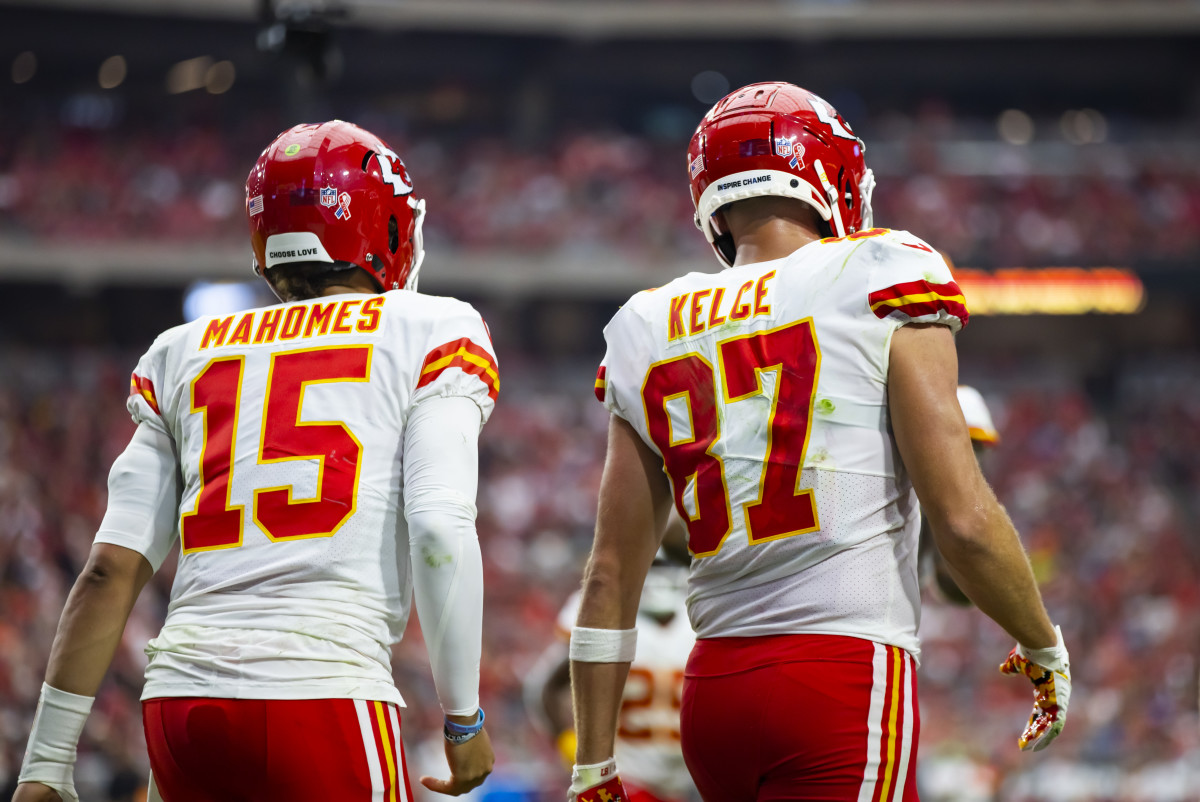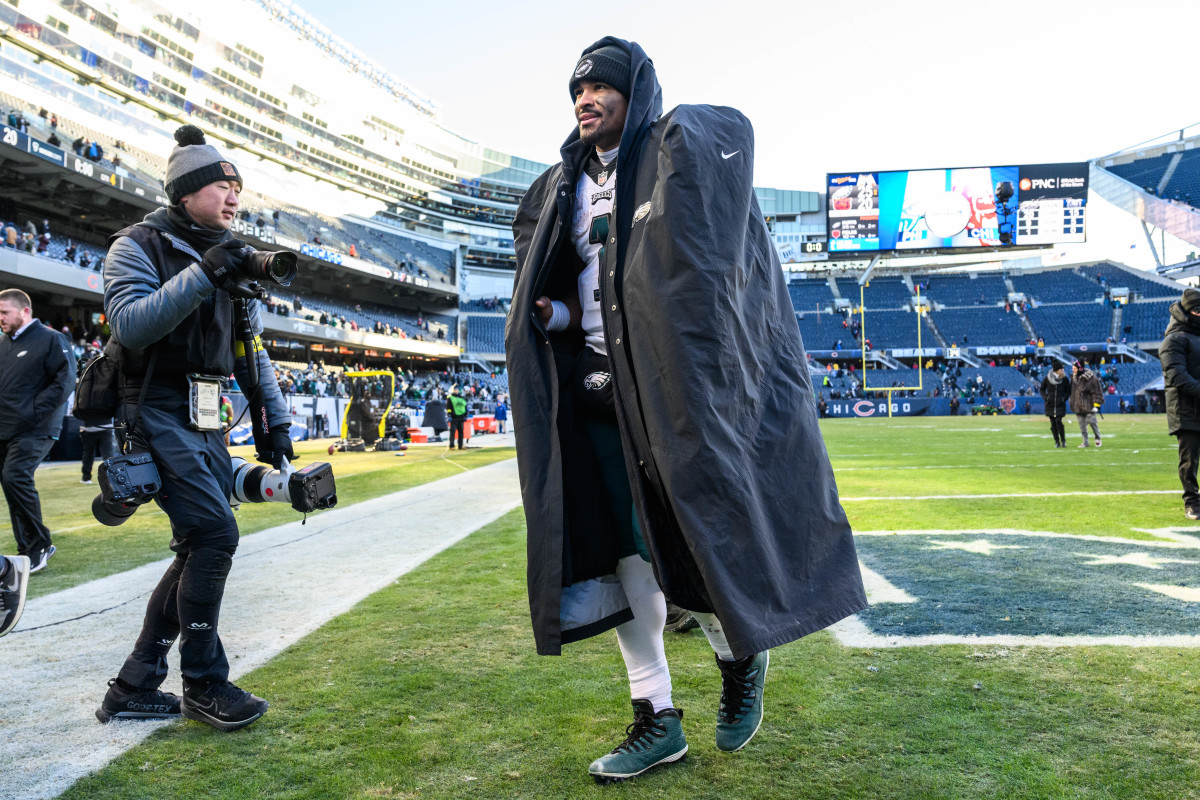Mahomes and Kelce, Summer-School Teachers
Patrick Mahomes really can do everything. That includes teaching, according to his private quarterbacks coach. Jeff Christensen saw this last summer, when Mahomes invited all his targets—several of whom were new to the Chiefs’ roster—to Fort Worth, Texas, where they’d train together to erase any concerns that the offense might not coalesce this season.
Christensen was there, but he didn’t run the sessions; that was intentional. Mahomes and Kelce did. “They became the teachers,” Christensen says.
Mahomes, for instance, would instruct his teammates on what he saw in certain coverages, where they should go, how they might shake their defender and the precise spot where he hoped to throw the football. He helped them understand his distinct, electric style of quarterback play. Kelce pointed out examples, in real time, on the field where they practiced. All would be applied to the upcoming season.

Christensen saw many benefits to this exercise. The teachers became better players and better teammates by being more accountable, and by explaining what they knew but maybe hadn’t voiced to this group before. The students understood not what Mahomes might like in a certain situation, but what he did like, what he wanted. The sessions also gave Christensen a greater respect for Andy Reid. He always saw Reid as a teacher first, anyway, and he could see the coach’s imprint on Mahomes and Kelce, not to mention how the Chiefs communicated offensive football. He knew then the offense would be just fine.
Recently, Christensen went back and reviewed videos from those sessions—the ones that portended the season ahead, and how the Chiefs would (unexpectedly, for most) be better on offense even after Tyreek Hill departed. He saw Mahomes tell teammates to come out of a particular break with just a little bit more lean, which signaled his attention to detail. He taught them how to sit down in zone coverage when a defensive back decides to wheel, and he was precise to the degree of the angle they should take.
One particular example stood out. Mahomes needed to leave, but Kelce stayed out there, for nearly an hour, working with three free-agent tight ends unlikely to make the roster, on route concepts. Christensen turned to Marquez Valdes-Scantling. “Are you seeing this?”
“I was in awe of it,” Christensen says. “Like, this is a Hall of Famer. This is one of the greatest players to ever play the game. And look how much he cares about these kids and helping them reach their dreams.”
THEN TO NOW:
I loved this, from 2020, when Patrick Mahomes’s life was changing rapidly, and that set the stage for his growth to now. (I happened to be at the same dinner, hence my chance to capture the scene.)
“On Feb. 21, almost three weeks after the Super Bowl triumph that changed everything, Mahomes traveled to Las Vegas for the heavyweight boxing rematch between Deontay Wilder and Tyson Fury. Before settling in ringside, he stopped by an invite-only dining room tucked into a corner of the MGM Grand Casino, strolled past security stations and into a private space called The Mansion. As dumplings and noodles and mouth-watering duck slices spun around an oversize banquet table, the quarterback shook hands and took pictures. But what he really wanted was to meet one of the dinner guests, NBA legend and longtime personnel executive Jerry West. “The Logo!” Mahomes shouted excitedly as he beelined toward West’s far-corner seat and the two huddled for a brief conversation.
At that point, something unexpected happened. A white, 82-year-old hoops lifer who grew up poor in West Virginia and a biracial, 25-year-old football star raised in part by a professional athlete in Texas connected instantly. They bonded by speaking the same language: greatness.
“He’s like a young puppy for Christ’s sake,” West told Sports Illustrated. The basketball Hall of Famer had not expected the burgeoning superstar to be “that disarming” and “that gifted” all at once. He told friends after that he’d pay to watch only three football players: Tom Brady, Aaron Rodgers and Mahomes. “He’s going to create a new kind of quarterback,” West says. “He can throw through a keyhole.”
After their meeting, Mahomes headed to Grand Garden Arena with Gavin Maloof, whose family owned the Palms Casino back when the most famous celebrities on the planet stayed, gambled and partied there. As Maloof watched the crowd all but swallow the quarterback, everyone screaming for autographs and cellphones trained on his every movement, the frantic landscape did not remind Maloof of the famous actors, broadcasters and musicians who once drew crowds in his casino. No, he’d seen only one celeb garner that same kind of reaction: the late Anna Nicole Smith.
Mahomes describes the whole sequence as “surreal,” speaking of meeting West the way someone might speak of meeting him. He can’t believe what happened the next week, when COVID-19 hot spots started popping up all over, followed by the shutdown of every major sports league. The fight marked the last truly normal experience for Mahomes’s postchampionship parade. Not that it mattered. He had another Super Bowl to win.
“This year will be one I’ll remember forever, for sure,” he says. “Win the Super Bowl. Becoming a girl dad. Getting engaged. Being in another Super Bowl. The pandemic. Social injustices.”
Mahomes lists the transformative events that redefined his world and the world in 2020 the way a regular human might compile a grocery list. Except instead of “buy broccoli,” his version is, “win the Super Bowl.” More proof of how his life changed but not him, not as dramatically as anyone could reasonably expect.”

ON BACKGROUND:
For two quarterbacks often described as fast healers, indications are that on Sunday both Mahomes and Jalen Hurts will be healthier than they were in their respective conference championship games. Some of that, surely, is upsell from teams that want this notion to be true. But both are healing, if not healed. (And this late in the season, no one is truly healed, anyway.)
QUOTE WITHOUT CONTEXT:
“I think it starts with Jeffrey.”
CONTEXT:
This is Howie Roseman, discussing the Eagles’ philosophy. He’s referring to his boss, owner Jeffrey Lurie. This is the rest of what he said.
“Jeffrey encourages us to not be risk-averse. And that’s in our decision, that’s in the people we hire. The league is set up for parity. It’s set up for teams to go 7–10, 8–9, 9–8. And so, to break out of that, you have to take some risks that give you a chance to be really good, but also to fall on your face. And sure, you know, we have seasons like we had in 2020.”
ELSEWHERE ON THE MMQB:
• Conor Orr on Nick Sirianni’s lineage, and a decision that birthed a family coaching dynasty
• Alex Prewitt on A.J. Brown’s two-sport background
• Albert Breer on Mahomes, Hurts and the rewards for thinking out of the box
